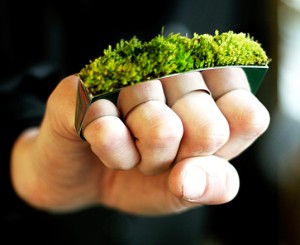People have been flashing “bling” around since the cave days. But what we perceive as “bling” has changed dramatically over the years and over cultures. We are social animals, we put a lot of value in our place in the social hierarchy of the group. By demonstrating wealth, we are advertising our social status in the community.
Body Image
 How can you tell how much influence a cave man had in his group? Well, one was probably the way he looked: body paint, tattoos, scarification, body modification, hairdos, teeth filings, nail beautification, and accessories. And while somethings were transitory—beads are easily lost in battle, nails broken during a hunt—some are permanent status symbols. When all you owe is carried on you, then permanent modifications is a good solution to broadcasting your importance and achievements to the group. Each scar carries meaning and is much easier to show off than notches on the bed post.
How can you tell how much influence a cave man had in his group? Well, one was probably the way he looked: body paint, tattoos, scarification, body modification, hairdos, teeth filings, nail beautification, and accessories. And while somethings were transitory—beads are easily lost in battle, nails broken during a hunt—some are permanent status symbols. When all you owe is carried on you, then permanent modifications is a good solution to broadcasting your importance and achievements to the group. Each scar carries meaning and is much easier to show off than notches on the bed post.
But body modifications is a very painful bling.
Products
 Once the society is a bit more stable, stuff becames a preferred way of social display. Jewelry can be worn, homes can be owned, cars can be seen—there are many ways to show off wealth in the age of stuff.
Once the society is a bit more stable, stuff becames a preferred way of social display. Jewelry can be worn, homes can be owned, cars can be seen—there are many ways to show off wealth in the age of stuff.
That is not to say that the other form of bling is gone from social display—tattoos, scars, paint, bindings, and body modifications can be shown off concurrently with display of stuff. And the kind of stuff that we find appealing changes culturally with time and geography. The Icelandic Moss Ring signals not only disposable income but also a certain political point of view on environmentalism.
If individuals in the society have limited resources (or only enough to survive), exhibition of wealth takes the form of well-fed babies. Cultures where food has been traditionally scares, see fat as bling.
Services
The next step in showcasing wealth is the ability to hire others to do work for you (freeing yourself to engage in pursuits of personal, idiosyncratic goals). Through out history people hired others to do chores that they couldn’t or didn’t want to do. In Roman times, regular citizenry went out for dinner every night—they couldn’t afford to eat at home. Only the rich Romans had the money for “built-in” kitchens. 100 years ago, most people living in US cities took their clothes to a laundry—they didn’t have the facilities to do the wash themselves. So home cooking and washing used to be luxuries.
But certain display of wealth through hired help were beyond the constrains of the times. Consider service a la Russe—each dinner guest waited on by a servant in a one to one ratio.

While the service was clearly excellent, it was more about the display of wealth and thus social status. And the tables were set with gold, silver, and porcelain so incredibly thin that it was translucent. Such displays were not about practicality…
Experiences
When life is full of goods and services, what is the next level of bling? English noblemen went off to climb mount Everest and to discover the the source of the Nile and to stand on the North and South Poles. Their wealth allowed them to lead the life of exploration. These feats were not easy and did advance human knowledge, but it was their wealth that allowed them to purchase experience.

Today, the bling frontier is Experiences—people who can afford them, look to buy ever more exotic experiences. And these displays of wealth contain it all:
- Body Image—most have to alter their physical selves to attempt these novel and exotic experiences.
- Products—you have to buy gear to participate.
- Guides—the services of expert trainers and guides are key to enjoying and surviving some of these experiences.
We live in an age where we can have it all! Even the less wealthy among us can purchase a little experience bling. The new status symbol is how many trainers you can hire to prepare you for your next action safari…

1 comment for “Demonstration of Wealth”